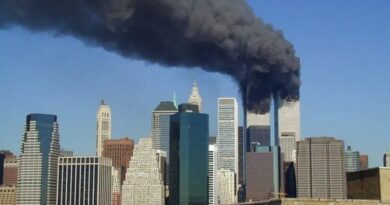9/11: Truth, Lies and Conspiracies review – the victims deserve better than this

There have been numerous brilliant documentaries made since 9/11, about the day nearly 3,000 people were killed in the largest ever terrorist attack on US soil, and its aftermath. Fifteen years on, if broadcasters had an ounce of courage or grace they would just rerun the best of them to mark each passing anniversary. Instead, we have 9/11: Truth, Lies and Conspiracies (ITV) which, while not as bad as it could have been, nevertheless marks the year the sound of barrel-scraping began to drown out the sound of history.
The film gave airtime to three kinds of believers. First there were the “truthers”, such as multimillionaire venture capitalist Jimmy Walter who remains convinced that explosives were used to blow up the towers to provide a pretext for the US government to take the country to war and boost the military-industrial complex. Then came the cover-up theorists who insist that government agencies are refusing to admit the mistakes they made, and that 9/11 could have been averted. Lastly were the conspiracy theorists, who claim that successive governments have lied about Saudi Arabian involvement in the attacks to protect national business interests.
There wasn’t enough information, though, to allow viewers to assess the value or likely truth (or “truth”) of competing claims. Former FBI special agent Mark Rossini’s claim that things would have gone better if the CIA, NSA and FBI had all been in perfect communication with each other, at all times, in the years leading up to the horror seemed more convincing than Walter’s notion that a hijacker’s passport was found in the street by the twin towers (“Not burned? Gimme a break!”) in order to frame al-Qaida. But how do you assess whether noticing a pattern of one person-of-interest’s phone calls to Yemen, or visits by another to a home in Sarasota, was a reasonable expectation before the event? Easy enough to trace their paths back afterwards, once the 15 hijackers had very clearly identified themselves.
Official committees, requests for documents, legal actions and journalistic pressures have not brought the answers many seek. Kathy Owens, who lost her husband in the attack on the World Trade Center, feels betrayed by her government twice over. Once by the failure to keep their people safe, again by the failure to own up to mistakes. Whether she’s right, or whether there simply are no answers that will satisfy the personally bereaved or the collectively outraged and psychically wounded is impossible – on the evidence of this programme at least – to say. But it is clear that the effects of the planes that suddenly appeared that day out of the bright blue sky are still too sad and awful to be borne without some busy, distracting search for explanation.
Anita Rani, Ade Adepitan, Ant Anstead and – letting the alliterative side down somewhat – Dan Snow presented a rather more uplifting view of New York last night as they finished off their three-part travelogue, New York: America’s Busiest City (BBC2), with a look at the people and the money and the politics it takes to keep the 20,000 trees, two ice rinks, seven “meadows” and 10km of pathways of Central Park going.
The Commissioner’s Plan – the grid system for New York, laid out in 1811 – originally contained no large open spaces. By the mid-19th century, the growing putrefaction of lower Manhattan had proved what a bad idea this was, so an area was set aside to create a place of sanitary salvation. Frederick Law Olmsted and Calvert Vaux won the design competition and the rest is history written in a countrified idyll laid over the Manhattan schist.
Around the periphery of what remains, against all the odds, a peaceful and democratic gathering place at the heart of probably the world’s most unequal city, the real estate is, of course, going crazy. Paula del Nunzio is NYC’s most powerful broker and took us round townhouses and penthouses worth millions, while Adepitan looked round rapidly gentrifying Harlem and Anita took in dun-gentrifying Brooklyn and everybody wondered where all the people who couldn’t afford to be gentry were going to go and how all the gentry were going to be served as gentry once they were gone.
Central Park is a testament to how things can change – as the city went near-bankrupt in the 70s, it was a byword for criminality and violence and is now a haven. But really, short of turning the whole of Manhattan into a communist province – a project that might cause even Jeremy Corbyn to quail – there really seem to be no answers to the madness unfolding just beyond its borders.


